Dschudsche GJOGSUL / GJOK-SUL
The close combat system of the People's Army of the People's Democratic Republic of Korea (PDRK)
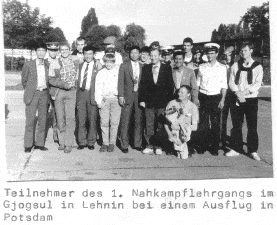 The Soviet army with its SAMBO-System that unites the different fighter-experiences and the experience of the war in Afghanistan, the Soviet military adviser in the exchange programme and the border fights at the Soviet-China border as well as their experience from the Vietnamese People's Army with their traditional VIET-VO-DAO system and their experience from the war against USA, controlled and led to a highly developed fight system. Unfortunately, the brotherhood weapons in this area were on leadership levels insufficient, none of the involved parties shared their experience and knowledge with each other.
The Soviet army with its SAMBO-System that unites the different fighter-experiences and the experience of the war in Afghanistan, the Soviet military adviser in the exchange programme and the border fights at the Soviet-China border as well as their experience from the Vietnamese People's Army with their traditional VIET-VO-DAO system and their experience from the war against USA, controlled and led to a highly developed fight system. Unfortunately, the brotherhood weapons in this area were on leadership levels insufficient, none of the involved parties shared their experience and knowledge with each other.Through the personal friendship of the head of the land forces of the National People's Army (NPA) of the former GDR, Colonel General Horst Stechbarth, with the head of state of the People's Democratic Republic of Korea (PDRK), Kim II Sung (15.04.1912-08.07.1998), an instructor team from North Korea was in 1988 brought to the GDR to execute a course on the north Korean close combat system Gjogsul.
There were altogether between 6th June and 5th August 1988 three consecutive three-week courses in the air-storm regiment-40 in LEHNIN in POTSDAM. The participating qualified soldiers from different fields of the GDR like paratroopers, soldiers for reconnaissance and long-range reconnaissance, fight swimmers (seals), border troops and military counterintelligence were specially chosen and listed by name in command 38/88 of the Minister for National Defence in the GDR.
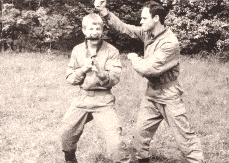
The North Korean instructor team consisted of 4 members.
2 instructors who were paratrooper officers and taught GJOGSUL at the North Korean Military Academy "Kim II Sung":
- Delegation leader Captain Rim Mjong Snob, 6 degrees in Gjogsul,
34 years old, married with 2 children, trained in Gjogsul for 14 years. - First Lieutenant Tschä Ho II, 5 degrees in Gjogsul,
31 years old, married with 1 child, trained in Gjogsul for 10 years..
In addition 2 interpreters:
- Major Bak Jong Kjun
- Lieutenant So Dzin, who studied German Language and Literature in Leipzig.
The basics of the North Korean close combat were offered in these courses. These basics proved to be of practical use in the battle against the Japanese and later the Americans. The Gjogsul is based on the bases of the old Korean fight systems.
The programme for the first three-week course in Gjogsul
| 1st Week: | ||
| Monday | Arrival Inauguration of course |
|
| Thuesday | 08.00 - 09.30 09.30 - 10.00 10.00 - 11.30 13.00 - 14.00 14.30 - 16.00 19.00 - 21.00 |
Review of skills Break Warm up and basic technique training Examination of training base Training in basic techniques Volleyball tournament |
| Wednesday | 08.00 - 09.30 10.00 - 11.30 13.00 - 14.00 14.30 - 16.00 19.00 - 21.30 |
Learning the kicks Learning the kicks Lecture on Gjogsul Repetition and technique training Visit restaurant |
| Thursday | 08.00 - 09.30 10.00 - 11.30 13.00 - 14.00 14.30 - 16.00 19.00 - 21.30 |
Learning complex exercises-1 (HYONG DONG ZAK IL) Learning complex exercises-1 (HYONG DONG ZAK IL) Lecture on the work of the sport organisation of land forces Practicing complex exercises-1 Swimming centre or Sauna |
| Friday | 08.00 - 09.30 10.00 - 11.30 13.00 - 14.00 14.30 - 16.00 |
Learning complex exercises-2 (HYONG DONG ZAK I) Learning complex exercises-2 (HYONG DONG ZAK I) Film "Close Combat: How train?" Practicing complex exercises-2 |
| Saturday | 08.00 - 09.30 10.00 - 11.30 13.00 - 18.30 |
Repetition Repetition Excursion: Potsdam - Cecilienhof and Army museum |
| Sunday | 08.00 - 09.30 10.00 - 11.30 15.00 - 19.00 |
Supervision of complex exercises 1 and 2 Learning complex attack combinations Excursion on the lakes about Potsdam |
| 2nd Week | ||
| Monday | 08.00 - 09.30 10.00 - 11.30 13.00 - 14.00 14.30 - 16.00 18.00 - 21.00 |
Learning from parry's with MPi Learning from parry's with MPi Personal studies 6. conference ZK of SED Practice from parry's with MPi on land Sport evening |
| Thuesday | 08.00 - 09.30 09.30 - 10.00 10.00 - 11.30 13.00 - 14.00 14.30 - 16.00 19.00 - 21.30 |
Learning from 10 pistol defences Learning from 10 pistol defences Political information Visit to the ATZ-40 (training centre) Visit restaurants |
| Wednesday | 08.00 - 09.30 10.00 - 11.30 13.00 - 14.00 14.30 - 16.00 19.00 - 21.30 |
Learning complex knife exercises Learning from 10 knife defences Film "Close combat for specialists" Practicing knife defences Swimming centre or sauna |
| Thursday | 08.00 - 09.30 10.00 - 11.30 13.00 - 14.00 14.30 - 16.00 19.00 - 21.00 |
Leaning to throw knives Leaning to throw knives Lecture on Gjogsul general repetition Exchanging experiences on the development of the military close combat |
| Friday | 08.00 - 09.30 10.00 - 11.30 13.00 - 14.00 14.30 - 16.00 18.30 - 20.00 |
Defence against 3-5 attackers without weapons Defence against 3-5 attackers without weapons Lecture on the Olympic movement Defence against 8 attackers with weapons Cinema |
| Saturday | 08.00 - 09.30 10.00 - 11.30 Afternoon free |
Defence against 8 attackers with weapons Defence against 8 attackers with weapons |
| Sunday | 08.00 - 09.30
10.00 - 11.30 |
Learning defence attack combinations (complex attack combinations with a partner) Learning defence attack combinations |
| 3rd Week | ||
| Monday | 08.00 - 09.30 10.00 - 11.30 13.00 - 14.00 14.30 - 16.00 18.00 - 20.00 |
Testing exercises with boards and bricks Hard blow training Lecture on Gjogsul-competition Practical demonstration on Gjogsul-competition pistol shooting competition |
| Thuesday | 08.00 - 09.30 09.30 - 10.00 10.00 - 11.30 13.00 - 14.00 14.30 - 16.00 |
Repetition MPi defences and pistol defences Repetition MPi defences and pistol defences Film "The physical training by paratroopers" MPi defences and pistol defences test. |
| Wednesday | 08.00 - 09.30 10.00 - 11.30 13.00 - 14.00 14.30 - 16.00 19.00 - 21.00 |
Repetition of knife defences and combined attack defences Repetition of knife defences and combined attack defences Political information Knife defences and combined attack defences test Swimming centre |
| Thursday | 08.00 - 16.00 19.00 - 22.00 |
Preparation for the final presentation Closing party with cones |
| Friday | 08.00 - 09.00 09.00 - 10.00 10.00 - 11.00 departure |
Preparation for the presentation Presentation for the military attaché Evaluation course and course results. |
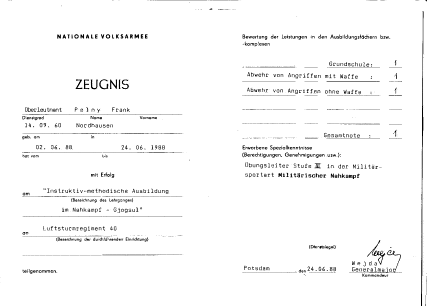
Through the evaluation of these course experiences, the military close combat system of the NPA was modified with suitable elements of the war-tested GJOGSUL. The result was a highly effective close combat system, which spread throughout the military forces.
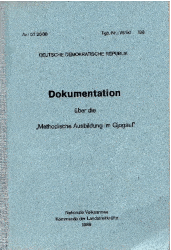
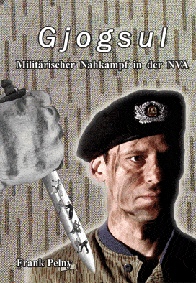 The technical basics of the GJOGSUL were through Captain Frank Pelny, a course participant, described in text and graphically represented in the "Dokumentation about the methodical training in Gjogsul" Ag 117 XL 111-03056-89), detachment of the military forces of the NPA 1989.
The technical basics of the GJOGSUL were through Captain Frank Pelny, a course participant, described in text and graphically represented in the "Dokumentation about the methodical training in Gjogsul" Ag 117 XL 111-03056-89), detachment of the military forces of the NPA 1989.
A total representation of the military close combat system including gjogsul resulted in Frank Pelny's book, "Gjogsul - military close combat in the NPA", which was released in 2005 by Books on Demand GmbH Norderstedt / Germany (ISBN 3-8334-2228-9; 352 Pages; about 550 photos) the book is available at the SaCO office.
HISTORY OF GJOGSUL
The roots of Gjogsul stretch as far back as 420 before time. At the time, there was a fight system in old Korea called Subak. The simple people practiced Subak and it involved defence with all rustic weapons against the warriors of the sovereigns who suppressed and robbed the people.
Subak actually means melon. To demonstrate one's capacity, it was necessary as a test to break open melons. Depending on the size and strength, the melons had to be cleanly cut into pieces with one blow from the edge of the hand. It was after this tradition that this style of fighting was called Subak.
In another version, people say that the aim was to strike the opponent to the floor with a stone-hard blow of the edge of the hand. This fight often had a deadly end.
With this depiction, it was clear to the experts of the East Asian martial arts that the roots of the Gjogsul were similar to the origins of the Taekwondo. That is the reality of it. Until the beginning of the 20th Century, there was still no defined difference in development between Taekyon and Gjogsul. It was not until the colonial rule of the Japanese in Korea in this century that there was a separation in the developments. The reason for this was simply that the people needed a fighting system against the Japanese with which they could be fully armed to fight their victorious enemies who were equipped with modern weapons. The almost unarmed people in most cases had to first disarm the enemy so that they too could have a chance. Many new techniques emerged, above all defence techniques against armed opponents like the attack techniques with these weapons.
1926 was officially made the year of origin of the Gjogsul. At this point in time, the leader of the Korean Resistance Fighters, Kim II Sung, trained in these special close combat techniques with his loyals so that they could successfully fight against the Japanese.
Most important in Gjogsul is that all positions, movements and fighting techniques prove their effectiveness in practical close combat and cause further development through practice.
Further essential impulses maintained the Gjogsul through the war in Korea from 1950 to 1953, in which the close combat techniques proved their effectiveness also against the physically superior American soldiers.
Based on the tense political and military situation at the border between North and South Korea, the development of the Gjogsul is until today at a standstill. There is for example a system in Gjogsul for the duel in and under water, which basically consists of hand techniques.
Today, the Gjogsul represents an essential training element in the military forces of the Korean People's Army. Every member of the army receives a Gjogsul training during his defence service. For the specialists, at least 300 to 400 hours Gjogsul training in a year is common.
Gjogsul is organised in eight training levels, four school degrees and four master degrees.
Through this narrow collaboration of the East European former communist countries with the Korean People's Republic, it was possible in around 1980 for the Korean Gjogsul masters to introduce their close combat system in some East European armies. There was secured knowledge on a special unit in the Polish Republic and on the paratrooper and special units of the military forces of the former GDR.

| Dschu dsche From personal strength (North Korean ideology by Kim Il Sung) |
Gjog Punching Play-offs Striking Attacking |
Sul Style Technique Fighting with consideration |
art of attacking create from own strength |
||
Gjogsul as a Contest
Gjogsul, as a realistic duel system, needs the permanent practical use and skill examination. A contest system was for this purpose developed which is, in the described form, today still carried out in the military forces of the Korean People's Republic. An independent contest system was built through its limited development in the National People's Army (NPA) of the former GDR. The Gjogsul contest is a full contact fight without weapons but with essential security equipment. The aim of the fight is for the opponent to mount the decisive hits as soon as possible. It's for this reason that with full contact and power, the attention and life of the partner are struck. The fight itself is from its course comparable to Box or Thai-box-fights. There are therefore frequently injuries.
Weight classes:
50, 55, 60, 65, 70, 75, 80 kg, +80 kg. all categories.
Fight Area:
- Similar to a boxing ring, area of 8 x 8 meters
- Height of the ring exhaustion 1,4 meters through a total of 4 ropes, one over the other.
- 0,5 meter security area around the ring, contestants in the red or blue
Fight Time:
After establishment 3 x 3, 4 x 3, 2 x 5 or 3 x 4 minutes. There is a one-minute break between the respective rounds.
Fight Outfits:
- Gjogsul suit (karate suit) or
- Short sport outfits (like the Thai boxing)
Security Equipment:
- Head protection
- Mouth protection
- Special gloves
- Elbow protection
- Depth protection
- Fighting is done bare-footed
Fight Court:
- Main referee:
responsible for the regular progress of the fight, controls the work of the referee and the side referee, double checks the list of participants, runs the contest list and defines the corners for the fighters. - Referee:
leads the fight in the fight area. - 3 - 5 side referees per fight area:
value the course of the fight and register it in the contest protocol. - Time keepers:
responsible for time keeping during the fight, announce the beginning of the fight three seconds before with a loud bang and the actual beginning with a gong or a bell, breaks and the end of a fight are announced with a gong and the end of the breaks after 45 seconds with a loud knock.
Fight Rules:
- All techniques in free form, individually or as a combination, are allowed.
- After a shock or a fall to the ground of a fighter, the attacker is allowed up to three seconds to strike back in order to bring on a technique. After three seconds, the fight will be broken up and up to 8 seconds for the one on the ground to get up.
- If a fighter falls to the ground three times or has three warnings within one round, he has lost the fight.
- The fight goes on until the end. In obvious defeat, the trainer can wave the towel to indicate the defeat of his fighter.
Punishment and Forbidden Actions:
Warnings:
-
- False blows (finger stings, scratching, techniques in the genitals)
- Repeated striking after the stop command
- Screaming and talking
- Inactivity.
Disqualification:
- Attack with full effect on someone lying on the ground after more than three seconds
- Having more than three warnings
- Unsportly behaviour or intentional injury of the opponent.
Estimations:
1/3 Point
-
- 1 effective blow
- 1 throw
1 Point
-
- Three times 1/3 Points
- K.O Blow
- Lever that led to the breaking of an arm or a leg.
1 Point deduction
- 1 warning
If an injured fighter has to leave, he has lost.